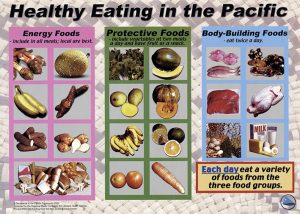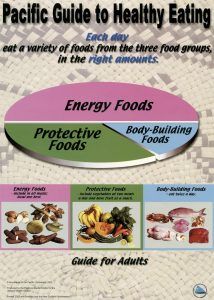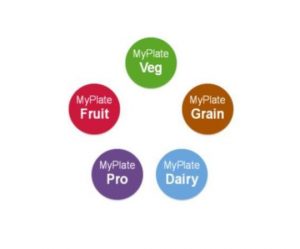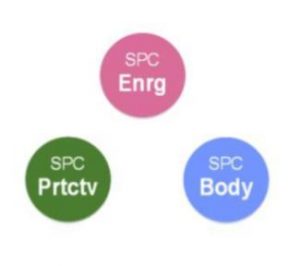Pacific Based Dietary Guidelines
To reflect the unique food environment and practices of the Pacific, the Secretariat of the Pacific Community (SPC) Public Health division developed Dietary Guidelines for healthy eating to promote and protect the health and future of Pacific Island peoples[1]. With such a diverse food supply, it can be difficult to place some pacific foods into the USDA 5 food group system. For example, ‘ulu, otherwise known as breadfruit, is a fruit but also has many similar properties and functions like whole grains as well due to its high carbohydrate and fiber content.
Therefore, guidelines for healthy eating include a series of leaflets and fact sheets that focus on traditional Pacific foods, food security, and health issues in the Pacific region. Healthy eating guidelines for adults and children are divided into 3 main food groups[2].
Table 12.6 The Different Categories from the Pacific
| Energy Nutrient-dense foods | Protective Foods | Body-building Foods | |
| Types of Foods | Foods that are both high in calories and high in nutrients | Fruits and vegetables | Protein-rich foods |
| Description | The recommendation is that these foods should be included in all meals contributing to about half of the food you consume each day. | The foods in this group are high in vitamins and minerals. These foods are recommended to be included in all meals and snacks contributing about one third of the food consumed each day. | The foods in this group are high in protein and is recommended to be eaten twice a day in small amounts. |
The recommendation is that these foods should be included in all meals contributing to about half of the food you consume each day. The foods in this group are high in vitamins and minerals. These foods are recommended to be included in all meals and snacks contributing about one third of the food consumed each day. The foods in this group are high in protein and is recommended to be eaten twice a day in small amounts. Examples of each of the foods from the Pacific that fit into these categories are shown in the image below.
Figure 12.8 Healthy Eating in the Pacific

The overall key messages to the SPC Dietary Guidelines are to consume a variety of foods each day from the 3 food groups. However, food should be consumed in moderation as too much of any one food can be unhealthy. Foods should be consumed in recommended amounts. In addition, every effort should be made to consuming foods that are locally sourced. See the image below for a depiction of the key messages of the SPC Dietary Guidelines.
Figure 12.9 The Pacific Guide to Healthy Eating

To learn more about the SPC visit http://www.spc.int/about-us/
Bridging MyPlate with the Pacific
Although the diversity and expansiveness of the Pacific region makes this a monumental task, a food guide that reflects the traditional foods of the Pacific in relation to the US Dietary Guidelines, more specifically MyPlate, was needed. The Pacific Food Guide was developed by the Children’s Healthy Living Program (CHL) for Remote and Underserved Minorities of the Pacific Region. CHL is a partnership among the remote Pacific jurisdictions of Alaska, American Samoa, CNMI, RMI, the Republic of Palau, FSM, Guam, and Hawai‘i to study child obesity among Pacific children, ages 2-8 years. The program is sponsored by the United States Department of Agriculture (USDA), Agriculture and Food Research Initiative Grant no 2011-68001-30335. To learn more about CHL visit http://www.chl-pacific.org/. The Pacific Food Guide is freely available at
http://manoa.hawaii.edu/ctahr/pacificfoodguide/index./about-the-guide/
Developed to assist with teaching introductory nutrition at the University of Hawai‘i at Mānoa, the Pacific Food Guide allows readers to explore the traditional foods of the Pacific in relation to both dietary guideline systems (USDA and SPC). Since foods of the Pacific cross over multiple categories of both the MyPlate and SPC Dietary Guidelines foods are organized into 3 neutral categories:
- Walks along the Ground (animals)
- Chosen from the Sea (seafood)
- Grown from the Ground (plants)
The Pacific Food Guide allows users to identify with the origin of specific Pacific foods and see how these foods fit into both dietary guidelines using a unique set of pins (see image below). By grouping foods into its origin it allows for readers who may not be familiar with either/neither dietary guidelines to use the Guide.

These pins label foods according to the USDA MyPlate guidelines and food groups.

These pins label foods according to the SPC food groups for healthy eating in the Pacific.
Note: There may be a few foods that do not fall in either of the 3 food groups, which the SPC regards as not essential or needed in significant amounts to achieve healthy eating. The recommendations for these miscellaneous food items are to “Eat Less” of, but not necessarily to avoid completely as they may have cultural and traditional value. Such food items will have this pin.
To learn more about how to use the Pacific Food Guide visit http://manoa.hawaii.edu/ctahr/pacificfoodguide/index.php/nutritional-guidelines/how-to-use-the-guide/
- Factsheet no. 16 – Healthy Eating. Secretariat of the Pacific Community. https://www.spc.int/hpl/index2.php?option=com_docman&task=doc_view&gid=58&Itemid=51. Published 2002. Accessed December 2, 2017. ↵
- Factsheet no. 9 – Feeding babies and young children. Secretariat of the Pacific Community. http://www.spc.int/hpl/index2.php?option=com_docman&task=doc_view&gid=51&Itemid=51. Published 2002. Accessed December 2, 2017. ↵

